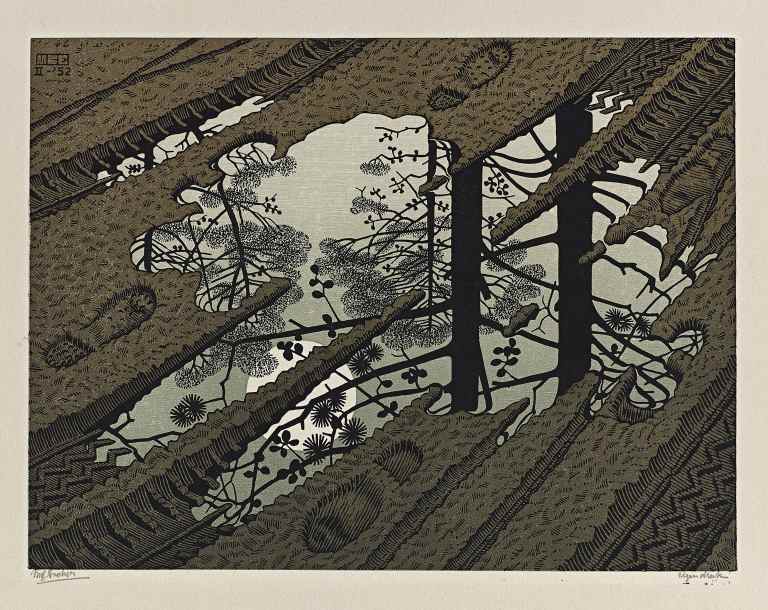Nendo adds another dimension to Escher's mind-bending works
By Robert Nelson
VISUAL ARTS
ESCHER X NENDO: BETWEEN TWO WORLDS
NGV International, until April 7
ESCHER X NENDO: BETWEEN TWO WORLDS
NGV International, until April 7
In an alpine landscape, a three-storey observatory rises into a clear sky with a twist. The bottom level runs north-west, while the upper levels run north-east.
In masterly etching technique, Maurits Cornelis Escher (1898–1972) has drawn this folly with high credibility. To assist the irrational slip in perspective, he swaps the base of the near columns for the far side of the balustrade. There’s no access to the upper level except for a precarious ladder that straddles the upper floors. It seems to be slanted the right way; but it would have to lean backwards in order to reach the outside at the top.
Populating this temple of linear madness is a dispersed crew of Chaucerian types: a philosopher-duke, a damsel high in the tower, a valorous knight who begins to climb towards her and an arrogant knave who will get there first, an artist-mathematician constructing a geometrical puzzle, a lover-couple from Bosch with swapped legs and a prisoner straining to contact the free world.
Called Belvedere, this baffling historical phantom creates paradoxes beyond simply the twist in perspective. The aristocratic privilege of the beautiful view ("belvedere") is based on oppression, literally built upon a jail.
In the enormous exhibition Escher X nendo there are many items of crafty genius, where the magicianship of impossible construction sets the scene for a symbolic action.
Another example is Ascending and descending, a renaissance palace of many loggias and parapets with a quadrangular gangway where all the steps go upward, without a downward return. So the marching men on the clockwise orbit go up the stairs eternally, while the men on the courtyard side go down the stairs in the opposite direction, also without relief. Their endless watch is observed by a lone figure from a lower rooftop and the utter glumness of the perpetual climb is summed up by a desultory figure sitting on the steps below.
Few artists create work that demands such prolonged inspection. Escher's involve unaccountable puzzles, irrational spaces and impossible constructions - but also a semantic jolt. All those disjointed spaces mean something. At times, it’s a symbolic disjunction in the social sphere but above all it’s a slippage in perception, a rift in the retina between two points that you cannot apprehend simultaneously but which your brain attempts to bridge.
I can’t see the point where the walls are twisted to make the stairs ascend in a continuous loop, just as I cannot identify the moment where the direction of the Belvedere snaps. My brain only wants to harmonise the two, in the same way that my mind wants to reconcile massive social inequities when I concentrate on the great musical, poetic and artistic themes of humanism.
All those disjointed spaces mean something.
The NGV faced two challenges in presenting this exhibition, which curator Cathy Leahy alludes to in an excellent catalogue. First, Escher’s work doesn’t fit into any 20th century art movement and hasn’t been championed by museums - despite ample admiration from the public and scientists (and lone art historians such as Ernst Gombrich).
And second, a black-and-white print struggles to gain attention in a world excited by other media.
So the decision to partner with Japanese design studio nendo is brilliant. It indicates a new currency and relevance to design but also brings a new kind of attention to the static image. Through the design of Oki Sato, the graphic work of the Dutch master is curiously extrapolated, expanded and drawn into three dimensions with added lustre and permutations.
The extravagance of the nendo contribution could have been an artificial imposition, denying the studious hermetic isolation of Escher’s monastic spirit. But the inventions of nendo are so ingenious and winsome (and so well crafted) that the enterprising, outgoing designer seems to put an arm around the inward, withdrawn artist, giving us more reason to feel the intimate embrace of the small works on paper.
The nendo spaces, meanwhile, pick up on the seriality of Escher’s work - especially the tessellation of inverted units. The installations don’t really tackle the deeper paradoxes of perception and reason in Escher’s airlocked narratives. This contorted inwardness - with its perverse love of a fault line that trips the third dimension - is for Escher alone.
https://www.canberratimes.com.au/entertainment/art-and-design/nendo-adds-another-dimension-to-escher-s-mind-bending-works-20181218-p50mwq.html




0 Comments:
Post a Comment
Subscribe to Post Comments [Atom]
<< Home